Anatomy of the Inferior Alveolar Nerve
The inferior alveolar nerve is a branch of the mandibular nerve that passes through the mandibular canal to the mental foramen giving off various branches along the way to the teeth of the lower jaw and finally to the skin of the chin, and the skin and mucous membrane of the lower lip (Image #1 and #2). Whereas the lingual nerve is in soft tissue throughout its distribution, the inferior alveolar nerve enters the mandible (lower jaw) and travels down a boney tunnel called the mandibular canal before one branch innervates the gums on the front lower teeth (lip side) down to the floor of the mouth and up to the lip and the other branch exits the mental foramen innervating the midline of the lip to the corner of the mouth, extending down to the chin in an inverted triangle.
Image #1: Lateral view of the skull showing the mental foramen (opening for the mental nerve)

Image #2: Inferior alveolar nerve distribution (see the mental nerve exiting the mental foramen)
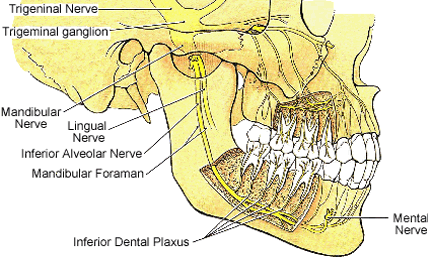
Image #2a: Lower Jaw (mandible) & the Inferior Alveolar Nerve & the Mental Nerve.

Image #2b: Lower Jaw (mandible) & the Inferior Alveolar Nerve, Lingual Nerve & the Long Buccal Nerve in relationship to the third molar (wisdom tooth).

Dental Malpractice and the Inferior Alveolar Nerve
Now that we have discussed the anatomy of the inferior alveolar nerve, we will turn to the dental procedures that cause inferior alveolar nerve injury:
- Negligent Implant Placement
- Negligent Root Canal Treatment (See Discussion in Root Canal Treatment)
- Negligent Fracture Of The Mandible
- Local Anesthetic
- Negligent Surgical Extraction of Lower Molars (See Discussion in Dental Malpractice and the Lingual Nerve and Cone Beam CT Scan )
1) Negligent Implant Placement
The most common dental procedure which causes injury to the inferior alveolar nerve is the placement of a posterior implant in the mandible (back of the lower jaw). The dentist can injure the inferior alveolar nerve in a number of ways during an implant procedure, but it all boils down to one fact, he/she doesn't know where the inferior alveolar nerve is. When a patient presents to the dentist and wants an implant to support an implant crown to replace a missing second molar in the posterior mandible, the dentist needs to determine the size and the width of the implant thay are going to place in this edentulous (open/missing tooth) space (see Image #3 below). The dentist knows that the inferior alveolar nerve is somewhere below where the missing second molar use to be and that every effort must be made to avoid injuring that nerve when placing the longest implant possible to ensure the future success of the implant. The dentist has been taught that he/she should provide a safety clearance of 2mm above the mandibular canal, so that the drill or implant does not injure the inferior alveolar nerve., and also to keep well clear of the mental nerve foramen (See Images 1, 2 and 2a above for the location of the mental foramen and mental nerve in the lower jaw).
Image #3: Missing Second Molar and Inferior Alveolar Nerve
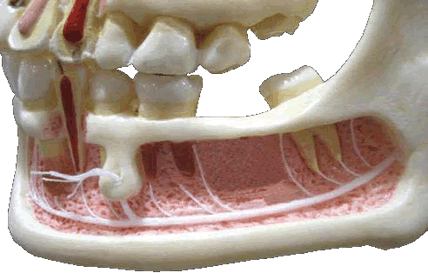
In order to determine the relationship of the inferior alveolar nerve to the alveolar crest (top of the bone in the space of the missing second molar) or to determine the relationship of the third molar to the inferior alveolar nerve, panorex x-rays or a periapical x-rays are used as screening readiographs to gage the appropriate length of an implant or the risk of injury to the inferior alveolar nerve during a third molar extraction. Both of these radiographs are two dimensional images and may provide incomplete radiographic information and may distort the anatomy with regards to the location of the inferior alveolar nerve. If these screening radiographs provide incomplete information determine where the alveolar nerve is in relation to the alveolar crest or demonstrate a close relationship of the third molar to the inferior alveolar nerve, the dentist must not guess where the inferior alveolar canal is and should refer the patient for a Cone Beam CT scan (CBCT: See discussion below). for determining the location of the inferior alveolar nerve in all three dimensions of the mandible (lower jaw). With the software that is available to the dentist, the radiographic information from this study can be used to manipulate the jaw in 360° and provide the most accurate information to the dentist for treatment planning for the placement of the implant (Image #4) or for a third molar extraction. When screening radiographs demonstrate the increased risks for implant placement or third molar extraction, it is below the standard of care for the dentist or oral surgeon to fail to explain the advantages of the CT or CBCT as a diagnostic option to the patient before the patient is subjected to the increased risk of nerve injury.
Image #4: Cone Beam CT scan of the missing second molar and the inferior alveolar nerve. Simplant software allows the dentist to manipulate the teeth, inferior alveolar nerve and mandible in all directions. Here the three dimensional Simplant view is compare with the panorex view, both of which are obtained by the CBCT.
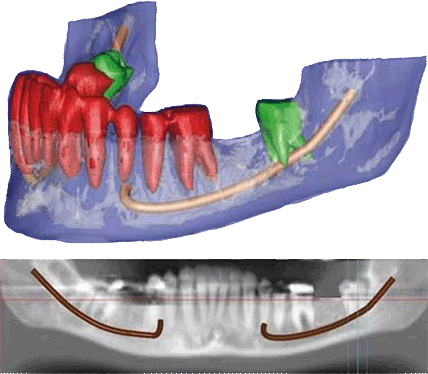
When the dentist has inadequate information or reads the panorex x-ray or the periapical x-ray incorrectly, he/she is at greater risk of injuring the inferior alveolar nerve while drilling the hole to place the implant in (Image #5). Unfortunately, there are occasions when the inferior alveolar nerve itself can branch, leaving one canal with calcified borders, and 1-2 other branches that may or may not have radiographically evident borders. This anatomical variation may be missed in periapical and panorex imaging, and may not always be identified in Cone Beam C.T. imaging either (See the CBCT discussion below to see the advantages of CBCT radiography when compared to panoramic radiography for third molar extractions).
Image #5: Dental drill injures the inferior alveolar nerve.
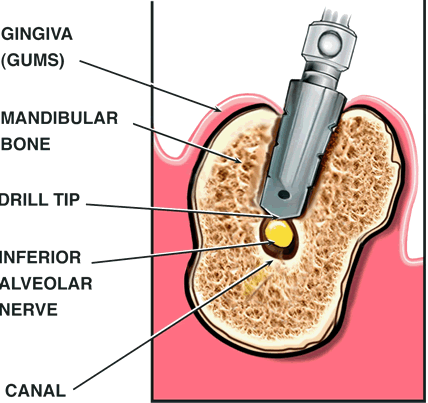
No dentist takes an x-ray with the dental drill in place, but frequently there is an x-ray with the implant seen violating the mandibular canal or touching it. Since the x-ray is in two dimensions, one cannot say the implant is in the canal, verses just overlapping the canal on the tongue (lingual) side or on the cheek (buccal) side of the canal. It is suspected that the drill preparation can violate the mandibular canal with poor technique, even though the post-operative radiograph of the implant in place shows the implant to be the appropriate 2mm above the canal. If the patient has anesthesia/paresthesia/dysesthesia symptoms, the dentist should know that he/she may have injured the inferior alveolar nerve with the drill when placing the implant or the implant is in the canal or impinging on the canal putting pressure on the inferior alveolar nerve. (see diagram in Image #6).
Image #6: Missing Second Molar and Inferior Alveolar Nerve
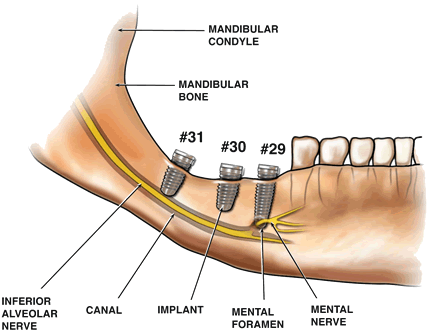
The standard of care requires the dentist to promptly remove the implant if the patient has immediate symptoms that reflect a compromise of the inferior alveolar nerve. Sometimes the implant can compress the bone below the tip of the implant, putting pressure on the inferior alveolar nerve. The pressure on the inferior alveolar nerve can cause symptoms of numbness, tingling etc. and when the implant is backed out the nerve may return to normal over time. It is negligent for a dentist not to remove an implant when it is causing immediate nerve symptoms. If the implant is causing symptoms, the dentist should take an x-ray to evaluate the implant and simply remove the implant. A Cone Beam CT scan (CBCT) can demonstrate that the dentist did indeed place the implant into the mandibular canal by showing where the missing bone is or the different density of the bone that has filled in (Image #7). If there is a delay in the removal of the problem implant after there has been full osseous integration around the implant (the living bone has grown around the threads of the implant), later removal can be problematic because now the implant can't be backed out and needs surgical removal with the inherent risk of additional nerve injury.
Image #7: Simplant/CBCT showing space previously occupied by removed implant

2) Negligent Root Canal Treatment
See Discussion in Root Canal Treatment
3) Negligent Fracture of the Mandible
It is negligent for a dentist to exert so much force during the extraction of a lower tooth as to cause a fracture of the mandible that cause injury to the inferior alveolar nerve. Sometimes a tooth is fused or ankylosed to the surrounding bone and it will not budge when the dentist tries to elevate it out using routine technique. More force is not called for in this situation. The tooth should be accessed and sectioned into pieces so as to avoid injury to surrounding anatomy. When a dentist uses brute force and ignorance, he/she can cause a fracture of the lingual plate causing injury to the lingual nerve and withextreme force the mandible can be fractured clean through causing a violation of the mandibular canal and injuring the inferior alveolar nerve (Image #8). A pre-operative panoramic radiograph may warn of a thinned and fragile mandible and provide the dentist with additional information regarding the risks of fracture that may require the skills of an oral maxillofacial surgeon. At a minimum, the dentist is required to inform the patient of this additional risk and give the patient the option of having the tooth extracted by an oral maxillofacial surgeon. Under these circumstances, the general dentist is well advised to insist on referring the patient to an oral maxillofacial surgeon for the extraction of this lower molar.
Image #8: Missing Second Molar and Inferior Alveolar Nerve

4) Local Anesthetic
Generally speaking, it is not below the standard of care for the dentist to injure the inferior alveolar nerve in the delivery of local anesthetic for a mandibular block (http://www.youtube.com/watch?v=bU_lBFr__Lg). The mandibular block is a procedure of giving anesthesia to the mandibular region to block certain areas from experiencing pain when the dentist needs to perform dental surgery in the oral cavity (Image #9). However, if the needle actually hits the nerve, making the patient jump, or if blood shows during aspiration (the dentist is required to pull back on the syringe plunger to make sure he/she is not in an artery) before injecting the local anesthetic, the needle should have been backed off slightly before injecting the anesthetic. A needle strike of the nerve can be masked if multiple injections are needed to achieve anesthesia.
Image #9: Mandibular block
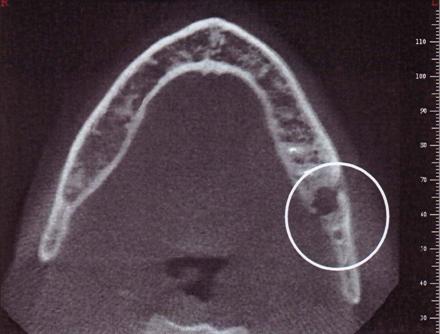
If the Inferior alveolar nerve is blocked with the anesthesia solution, then the whole nerve along with its subdivisions, including the mental nerve, incisive nerve, lingual and the long buccal nerve are blocked for a limited period of time from transmitting pain stimuli to the brain. The basic idea is to use anatomical landmarks to place the tip of the syringe in the approximate area where the inferior alveolar nerve enters the mandibular canal. Due to the differences in every person's anatomy, the dentist cannot guarantee that the needle will not actually hit the inferior alveolar nerve, causing a partial nerve injury with paresthesia/dystesthesia. These injuries usually resolve, but on rare occasions can develop into a sustained neuropathic pain. The dentist does have an obligation to chart your nerve injury and to map it in the chart, so as to follow it accurately for healing. If the symptoms are improving with respect to intensity and distribution, the dentist may not need to refer the patient to an oro-facial pain specialist. If there is significant paresthesia/dysesthesia and it is not resolving, the patient should be referred to an oral surgeon who specializes in microsurgery and/or an oro-facial pain specialist before the fourth month of the injury. Most neurologists do not specialize in these injuries and you are better off being seen by the oral surgeon/oro-facial pain specialist before the pain becomes centralized to the brain and your treatment options become seriously diminished. The longer you wait, the less likely surgery will be an option for you.
5) Negligent Surgical Extraction of the Lower Molars
See Discussion in Dental Malpractice and the Ligual Nerve and Cone Beam CT Scan (CBCT)
Plaintiff's Burden of Proof
The burden of proof is upon the plaintiff/injured party to prove the dentist was negligent during the dental procedure that caused the injury to the inferior alveolar nerve or the dentist's post-operative care resulted in injury. The issues of proof will be influenced by the nature of the injury i.e. anesthesia, paresthesia, dysesthesia. Here are some of the considerations to determine if there is a basis for a claim against a dentist for the negligent injury of the inferior alveolar nerve:
a. Is there a signed written consent form listing the risks of nerve damage;
b. Are there timely and adequate x-ray studies of the teeth involved in the dental procedure both before and after the procedure. Do the pre-treatment radiographs completely visualize the teeth the dentist worked on and their important surrounding anatomical landmarks (see Cone Beam CT or CBCT below);
c. Was this a high risk extraction that should have been referred by the general dentist to an oral surgeon. Is the third molar fully erupted, partially erupted or fully impacted. What is the position of the tooth and where is in located in relationship to anatomical landmarks. An extraction that results in injury to the lingual nerve and the inferior alveolar nerve indicates poor surgical technique;
d. Was this a high risk implant procedure that should have been referred by the general dentist to an oral surgeon or periodontist for the placement of the implants. Were there adequate bone levels before the implants were placed. What is this dentist's experience level with placing implants;
e. Was improper technique used, resulting in improper measurement of the implant length or resulting in a fracture of the mandible;
f. Often the dentist says the dental procedure was straight forward and went smoothly without incident, so the length of time that the procedure actually took may be an indicator that the dentist is had more difficulty with the procedure than reported;
g. Did the dentist properly treat the acute nerve inflammation post-operatively and follow the healing of the nerve injury or lack thereof with nerve mapping to determine if there is any improvement in the nature and/or distribution of the patient's symptoms (See Image 6b above). Sometimes the territory of numbness or neuropathicpain becomes smaller over time and if it does not; the dentist may be required to makeappropriate referrals (see h. below);
h. Did the general dentist/oral surgeon timely refer the patient to an oral-facialpain specialist to treat the patient's neuropathic pain before the problem became worse? Did the dentist refer the patient to an oral surgeon trained in micro-surgery to timely present the patient with the options of nerve decompression microsurgery (removing a hematoma, scar tissue or anything that impinges on the nerve) or nerve re-anastomosis microsurgery (suturing the severed lingual nerve ends together);
i. Does a subsequent Cone Beam CT (CBCT) or exploratory surgery by a microsurgeon confirm the location and nature of the inferior alveolar nerve injury. If the CBCT demonstrates that the mandibular canal has been violated or if the surgeon directly visualizes the injury to the inferior alveolar nerve, the defense will not be able to argue that the standard of care mandibular block (local anesthetic) caused the patient's inferior alveolar nerve injury symptoms
Defense Arguments
The defense will argue the following:
-
the inferior alveolar nerve was injured during the administration of the local anesthetic for the subject dental procedure (mandibular block) and due to the implant placement, etc and that this is an unavoidable risk of a mandibular block. This argument is a more effective argument in cases of paresthesia (incomplete severing of the inferior alveolar nerve), than with complete anesthesia (complete severance of the inferior alveolar nerve) given the width of the bevel tipped syringe needle and the width of the inferior alveolar nerve at the location of the mandibular block;
-
the general dentist is experienced in placing implant, performing extractions, doing root canal treatments, etc. and there was no need to refer the plaintiff to an oral surgeon or alternatively, the dentist did refer the plaintiff to an oral surgeon (failed to record this fact in the dental records), but plaintiff chose to spend the extra money;
-
the plaintiff signed a written consent acknowledging the risks of nerve injury, etc. If there is no written consent, the defense will argue that plaintiff was orally informed of the risk, whether the dental chart confirms this or not;
-
the dentist performed an excellent textbook implant placement, extraction, root canal treatment, etc. using appropriate technique for the subject dental procedure. Bad things just happen;
-
the subject implant placement, extraction, root canal procedure, etc. appeared from the diagnostic workup by the treating dentist to be an uncomplicated procedure;
-
the plaintiff has an incomplete injury to the inferior alveolar nerve and the symptoms of paresthesia/dysesthesia will resolve in time (certainly after the jury verdict).

